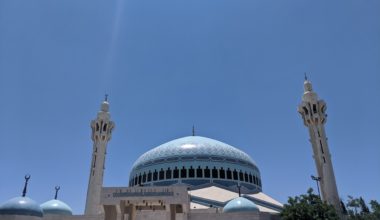By Ariell Ahearn, University of Oxford, and Olivia Mason, University of Newcastle.
“They took our view away from us,” was a phrase repeated to us by former residents of Dana Village. They were referring to the Royal Society for the Conservation of Nature (RSCN)’s luxury guesthouse built onto the cliff at the edge of Dana Village, with spectacular views of Wadi Dana and the RSCN Dana Biosphere Reserve. On clear days, the guesthouse balcony provides views over Wadi ‘Araba and the Negev. We were in Dana to do a small CBRL-funded research project to understand perceptions of the Dana Reserve amongst local stakeholders, explore current land use practices, and investigate alleged plans for building a mine in Faynan (or Feynan) in an area in the southwest of the Dana Biosphere Reserve.
Our fieldwork followed the workshop Dana+20: Mobile Indigenous Peoples, Conservation, Sustainable Development and Climate Change Two Decades after the Dana Declaration, which brought together 40 representatives of mobile pastoralist groups from around the world to discuss shared concerns regarding rights to mobility, pasture fragmentation, the impacts of climate change, conservation and industrial development on mobile peoples. Representatives from the areas of Dana, Wadi Rum, Wadi Hidan, and Petra in Jordan joined delegates from twelve countries to reflect on and update the Dana Declaration on Mobile Peoples, which was penned in Dana in 2002.
Dana was chosen as the location for the 2002 event due to the designation of 308 square km of land as an official RSCN nature reserve and subsequent limitations placed on local agro-pastoralists from the past grazing and cultivation areas. Our opening quote, describing the commodification of the view for luxury eco-tourism, points to wider themes which emerged in our research, including power dynamics within existing land governance, the fracturing of cultural landscapes, the commodification of nature, and tensions between development and environmentalism. Past and present land use and development in the Dana Biosphere Reserve are complex. This short blog will introduce these themes to provide a starting point for more critical discussions of environmental governance, sustainable development, and relationships between communities and environmental policies in the region.


Environmental Governance
The history of environmental governance and nature conversation in Jordan can be traced to the establishment of the RSCN in 1966. Originally established in 1966 as a nature society by a group of Jordanian hunters who noticed the rapid decline of wildlife, proposals by British scientists for a series of national parks in Jordan and the support of King Hussein saw the organisation move from a social group to an organisation with royal patronage (Burnett and Schneider, 1999). The plans set out for managing nature reserves in Jordan in the late 20th century drew on British and North American conservation practices and echoed global discourses within environmental conservation that viewed pastoralists as degraders of nature resources (Chatty 2002; Rowe 2006). The Dana Reserve was established in 1993 as a flagship conservation area in this context. Within this history, tensions over local development and the environment began and continue to persist. Conflicting research reports on the impact of grazing and cultivation in the area exacerbated these tensions (Rowe 2006).
As numerous studies have highlighted, there has been long-standing seasonal use of fertile spring-fed wadis by pastoralists and agro-pastoralists between Dana and Faynan (Palmer and Daly 2006; Palmer et al. 2007). This highlights the longer history of engagement and knowledge of the land held by local communities. Indeed, this knowledge now informs the expertise of local tourist guides who lead foreigners through the wadis and trails around the Reserve. Yet, this knowledge was rarely recorded, with the early activities of conservation science primarily focused on cataloguing unique species of flora and fauna, perhaps due to the persistence of degradation discourse, which presents pastoralism as the cause of land degradation and biodiversity loss (Hobbs 2006).
For instance, in several interviews with government officials, uncontrolled grazing was frequently cited as a reason for the loss of trees and plant species. Yet, in interviews with local communities, the exact opposite was cited to us. We were told that livestock grazing on trees can stimulate them to grow, that goats and sheep provide essential fertiliser, and that the movement of grazing animals carries seeds. Only dead parts of trees or small branches were ever cut off trees as they knew that would prompt trees to grow back for future generations. Yet, at the same time, some community members told us that when access to the Reserve was lost, people began deliberately chopping down trees as they felt a lack of ownership over the area. This sentiment is reflected in a blog written by the Dana Cooperative in October 2021 called “Unheard Voices: The Dana Nature Reserve and the People of Dana”.
The RSCN has in recent years acknowledged the importance of enabling limited grazing, yet sharing of environmental knowledge between groups is still limited. Moreover, a long history of physical restrictions placed on agro-pastoral communities in the area where the Dana Biosphere Reserve lies further exacerbates traditional livelihoods. For instance, many of the Bedouin in Faynan, in the lower reserve, were displaced from Palestine in 1948, which affected their ability to access land and citizenship rights (see Rowe 2006; Palmer et al. 2007). Environmental governance in the present must thus be cognisant of these histories. The absence of governance mechanisms to enable participation of local communities is a topic of concern throughout Jordan, with many local communities feeling they are excluded from NGO boards. These concerns are exacerbated by often complicated and overlapping governance structures. For instance, in Dana the Municipality of Qadisiyya, the RSCN, the Ministries of Agriculture and the Environment (among others) have differing, overlapping, and sometimes conflicting levels of governance over the Dana Biosphere Reserve.
Sustainable development and the commodification of nature
Returning to the commodification of the view by the RSCN Dana Guesthouse, environmental officials in Jordan emphasised the idea that preserving the environment requires stable income. We were also told in interviews that the Dana Biosphere Reserve rarely makes profit from tourism. Yet, this question of profit, prompts wider discussions around what happens when conservation and capitalism intersect. The establishment of Wild Jordan, as a registered trademark of the Royal Society for the Conservation of Nature, aims to produce revenue that ‘contributes to the sustainability of RSCN’s protected areas and supports the socioeconomic development of local communities’ (RSCN 2023). While the need for income to support environment work, especially in middle-income countries such as Jordan, is important, it can also lead to the commodification of nature, and the balance between income generation and conservation must be finely balanced.

The creation of the Dana Reserve and growth of tourism in the South of Jordan further intersects with wider political, economic, and social dynamics in the region, including urbanised livelihoods, rapid population growth, and high rates of unemployment. In both Dana and Faynan, young men were concerned about the lack of employment opportunities available locally. Tourism thus becomes an employment option that creates local dependencies and conflicts as one of the few well-paid jobs. In Faynan, this made the prospect of a potential copper mine attractive as jobs in the tourist industry were limited. While small-scale mobile pastoralism was visible in Faynan amongst the ‘Azazma and Rashaydah tribes, there was pressure on natural resources from the establishment of farms and a reluctance amongst youth to adopt this way of life (though parades of traditionally decorated camels and horses generated great respect during a Bedouin wedding that we were spontaneously invited to). In Dana, a herder that we interviewed estimated that there were only 8-10 people still practicing mobile pastoralism. Indeed, the RSCN assisted by GEF funding has used a development model to make ‘good the loss of income incurred through grazing restrictions’ by promoting tourism (Rowe 2006: 771).

The expansion of tourism and tourist trails has been celebrated as a form of sustainable development and conservation. While the trails themselves are free to access, tourists are required to pay to access the Reserve, and it is highly recommended that tourists hire a guide when walking on most of the trails. These trails can provide important sources of income and opportunities for environmental awareness by connecting tourists more intimately to land. However, little is said about the impact of tourism on the environment, the unequal benefits of tourism, and the politics of mobility associated with tourism (Mason 2021). According to the Jordan Times (Dec 2017), 80,000 tourists visited the Dana Reserve prior to the pandemic in 2017. Large-scale tourism creates traffic, pressure on water resources, large amounts of plastic waste and noise pollution. Furthermore, despite our research highlighting limited numbers of Bedouin still practicing mobile pastoralism, dominant narratives still blame over-grazing for land degradation and plant biodiversity loss despite lack of scientific evidence. Tourism is rarely cited as a problem for the environment.
References:
Burnett, G.W. and I. Schneider (1999). A Private Affair: Nature Reserves in the Hashemite Kingdom of Jordan. The George Wright Forum 16 (2): 75-87. https://www.jstor.org/stable/43597638.
Chatty, D. 2002. Animal Reintroduction Projects in the Middle East: Conservation without a Human Face. In D. Chatty and M. Colchester (eds) Conservation and Mobile Indigenous Peoples: Displacement, Forced Settlement and Sustainable Development. New York: Berghahn books.
Hobbs, J. 2006. Guidelines for the Involvement of Nomadic Pastoralists in Conservation and Development Efforts. In Nomadic Societies in the Middle East and North Africa. Edited by D. Chatty. Brill.
Jordan Times (2017). Dana Reserve Witnesses 33 percent rise in numbers of visitors. Found at: http://www.jordantimes.com/news/local/dana-reserve-witnesses-33-cent-rise-number-visitors
Mason, O. (2021). A political geography of walking in Jordan: Movement and politics. Political Geography, 88, online first. https://doi.org/10.1016/j.polgeo.2021.102392
Palmer, C. and P. Daly. 2006. Jouma’s Tent: Bedouin and Digital Technology. In Digital Archaeology: Bridging method and Theory. Edited by Thomas L. Evans and Patrick Daly. London: Routledge.
Palmer, C., Smith, H. and P. Daly. 2007. Ethnoarchaeology. In Archaeology and Desertification: The Wadi Faynan Landscape Survey, Southern Jordan. Edited by G. Barker, D. Gilbertson, and D. Mattingly. Council for British Research in the Levant.
Rowe, A., 2006. Conservation, Land and Nomadic Pastoralism: Seeking Solutions in the Wadi ʿAraba of Jordan. In Nomadic Societies in the Middle East and North Africa (pp. 759-784). Brill.
Royal Society for the Conservation of Nature (2023). Overview. Found at: https://www.rscn.org.jo/overview.
About the authors
Dr Ariell Ahearn is a Departmental Lecturer in Human Geography in the School of Geography and the Environment at the University of Oxford, UK. Her research focuses on contemporary practices of mobile pastoralism and environmental governance.
Dr Olivia Mason is a Research Associate in Human Geography in the School of Geography, Politics, and Sociology at Newcastle University, UK. Her research sits at the interface of cultural, environmental, and political geography, and explores mobility politics and resource colonialism with a focus in the MENA region.
The views expressed by our authors on the CBRL blog are not necessarily endorsed by CBRL, but are commended as contributing to public debate.















